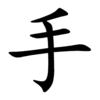手
| ||||||||
Translingual
| Stroke order | |||
|---|---|---|---|
 | |||
Alternative forms
- 扌 (when used as a left Chinese radical)
Han character
手 (radical 64, 手+0, 4 strokes, cangjie input 手 (Q), four-corner 20500)
- Kangxi radical #64, ⼿.
Derived characters
- Index:Chinese radical/手
References
- KangXi: page 416, character 28
- Dai Kanwa Jiten: character 11768
- Dae Jaweon: page 762, character 9
- Hanyu Da Zidian: volume 3, page 1824, character 1
- Unihan data for U+624B
Chinese
| simp. and trad. |
手 | |
|---|---|---|
| variant forms | 𠂿 | |
Glyph origin
| Historical forms of the character 手 | |||||
|---|---|---|---|---|---|
| Western Zhou | Warring States | Shuowen Jiezi (compiled in Han) | Liushutong (compiled in Ming) | ||
| Bronze inscriptions | Chu Slip and silk script | Qin slip script | Ancient script | Small seal script | Transcribed ancient scripts |
 |
 |
 |
 |
 |
 |
| Characters in the same phonetic series (手) (Zhengzhang, 2003) | |
|---|---|
| Old Chinese | |
| 杽 | *n̥ʰɯwʔ |
| 手 | *hnjɯwʔ |
Pictogram (象形) – hand and fingers. The top stroke is the bent over middle finger, while the horizontal strokes are each two fingers. Compare 爪, 寸, 九.
Note that unlike the other hand/claw characters, 手 has consistently had five fingers: a mammalian/human hand, as opposed to the three digits often found in the others.
Compare also 止 (“foot”), derived from a footprint, originally composed of 3 toes and a sole.
Pronunciation
Definitions
手
Compounds
Derived terms from 手
|
|
|
Japanese
Readings
Noun
- hand
- handle
- paw, foreleg
- way of doing something, means
- (board games) a move; a play
- 2002 March 9, Hotta, Yumi; Obata, Takeshi, “
第 131局 試 される伊 角 [Game 131: Isumi’s Endeavor]”, in ヒカルの碁 [Hikaru’s Go], volume 16 (fiction), Tokyo: Shueisha, →ISBN, page 54:- まだそんな手が残ってた——投了は早すぎた
- Mada sonna te ga nokotteta—— Tōryō wa hayasugita
- There’s still that move—— I gave up too soon
- まだそんな手が残ってた——投了は早すぎた
-
Suffix
Kunigami
Pronunciation
- IPA(key): /tʰiː/
Mulam
Okinawan
Pronunciation
- IPA(key): /tiː/
Yonaguni
Pronunciation
- IPA(key): /tiː/
References
- Nguyễn et al. (2009).
- Trần (2004).
- Bonet (1899).
- Génibrel (1898).
- Taberd & Pigneau de Béhaine (1838).
This article is issued from
Wiktionary.
The text is licensed under Creative
Commons - Attribution - Sharealike.
Additional terms may apply for the media files.